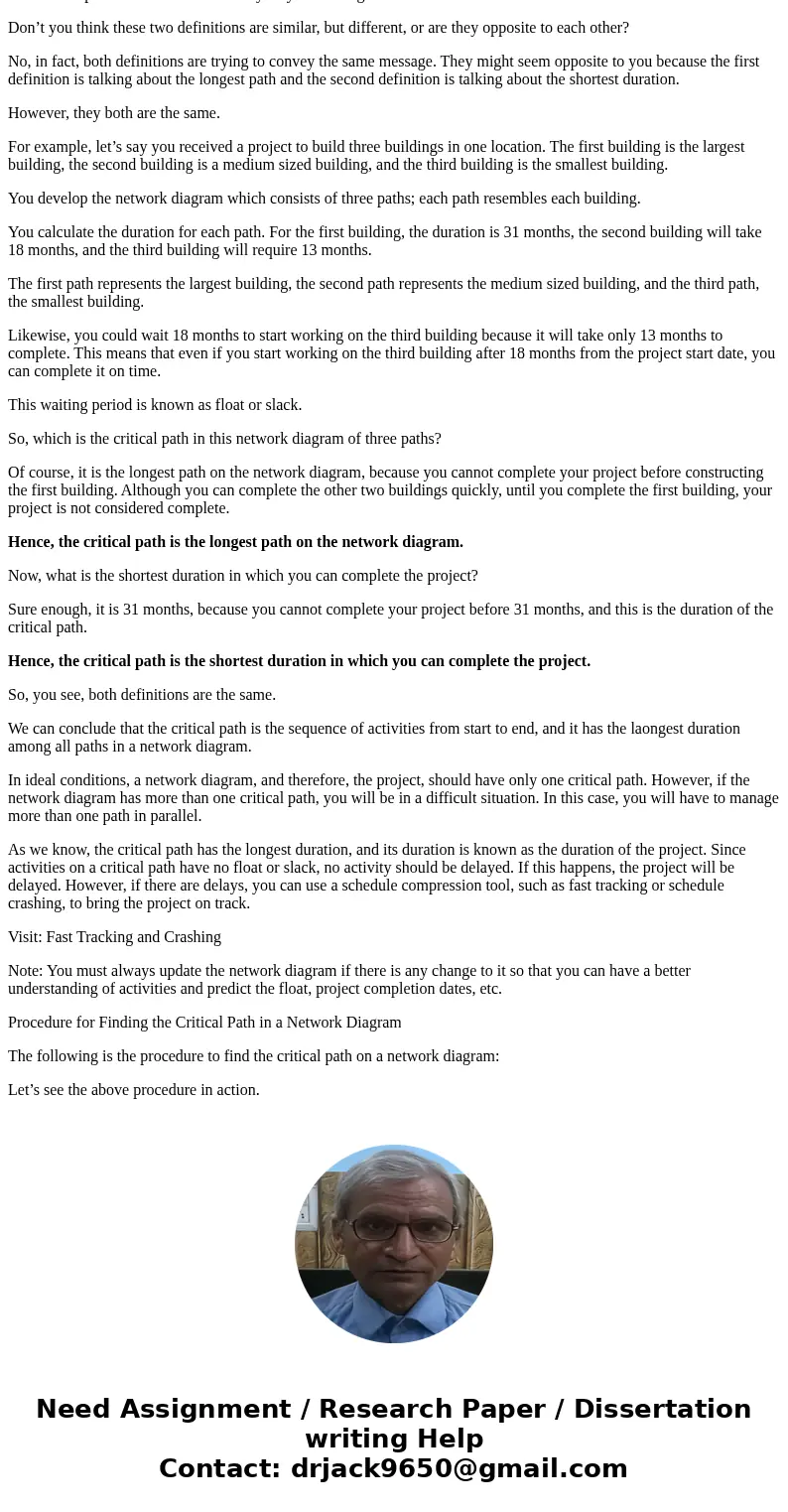Identify the critical path and project total duration Identi
Identify the critical path and project total duration. Identify the slack available for each task. Discuss what would happen to the critical path if task E ends up lasting 19 days instead of the 12estimated. Please see this link to view the diagram please.
http://www.chegg.com/homework-help/questions-and-answers/use-network-aoa-diagram-answer-question-tasks-labeled-letters-duration-task-also-given-ide-q17503709
Solution
The critical path method (CPM) is used extensively by project planners worldwide for developing the project schedule in all types of projects including IT, research, construction.
This method is a basis of the project schedule and is discussed very broadly in the PMBOK Guide. You can expect to see two to three questions, or more, in your PMP exam from this topic.
In this blog post, I will discuss the critical path with a real world example, identify the critical path in a network diagram, and calculate the float for each path. I will then list some of the benefits and limitations of the critical path method.
Once you become familiar with it, I will walk you through every step required for calculating Early Start, Early Finish with forward pass, and then calculate Late Start, Late Finish with backward pass.
Make sure you understand each step described, otherwise you might face some difficulties when working with these calculations. If you feel you need any clarification, feel free to reach out to me at any time.
Critical Path
If you look at any network diagram, you will notice many paths originating from one point and ending at another point. Every path will have some duration, and the path with the longest duration is known as the critical path.
The critical path can be defined in many ways including:
Don’t you think these two definitions are similar, but different, or are they opposite to each other?
No, in fact, both definitions are trying to convey the same message. They might seem opposite to you because the first definition is talking about the longest path and the second definition is talking about the shortest duration.
However, they both are the same.
For example, let’s say you received a project to build three buildings in one location. The first building is the largest building, the second building is a medium sized building, and the third building is the smallest building.
You develop the network diagram which consists of three paths; each path resembles each building.
You calculate the duration for each path. For the first building, the duration is 31 months, the second building will take 18 months, and the third building will require 13 months.
The first path represents the largest building, the second path represents the medium sized building, and the third path, the smallest building.
Likewise, you could wait 18 months to start working on the third building because it will take only 13 months to complete. This means that even if you start working on the third building after 18 months from the project start date, you can complete it on time.
This waiting period is known as float or slack.
So, which is the critical path in this network diagram of three paths?
Of course, it is the longest path on the network diagram, because you cannot complete your project before constructing the first building. Although you can complete the other two buildings quickly, until you complete the first building, your project is not considered complete.
Hence, the critical path is the longest path on the network diagram.
Now, what is the shortest duration in which you can complete the project?
Sure enough, it is 31 months, because you cannot complete your project before 31 months, and this is the duration of the critical path.
Hence, the critical path is the shortest duration in which you can complete the project.
So, you see, both definitions are the same.
We can conclude that the critical path is the sequence of activities from start to end, and it has the laongest duration among all paths in a network diagram.
In ideal conditions, a network diagram, and therefore, the project, should have only one critical path. However, if the network diagram has more than one critical path, you will be in a difficult situation. In this case, you will have to manage more than one path in parallel.
As we know, the critical path has the longest duration, and its duration is known as the duration of the project. Since activities on a critical path have no float or slack, no activity should be delayed. If this happens, the project will be delayed. However, if there are delays, you can use a schedule compression tool, such as fast tracking or schedule crashing, to bring the project on track.
Visit: Fast Tracking and Crashing
Note: You must always update the network diagram if there is any change to it so that you can have a better understanding of activities and predict the float, project completion dates, etc.
Procedure for Finding the Critical Path in a Network Diagram
The following is the procedure to find the critical path on a network diagram:
Let’s see the above procedure in action.


 Homework Sourse
Homework Sourse